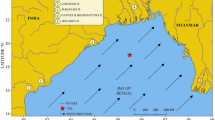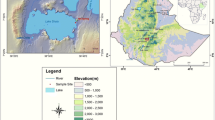Abstract
At all seasons, the underwater light field of meso-eutrophic large (480 km2) deep (mean: 100 m) Lake Constance was studied in conjunction with the assessments of vertical distributions of phytoplankton chlorophyll concentrations. Vertical profiles of scalar, downwelling and upwelling fluxes of photosynthetically available radiation, as well as fluxes of spectral irradiance between 400 and 700 nm wavelength were measured.
The overall transparency of the water for PAR is highly dependent on chlorophyll concentration. However, the spectral composition of underwater light is narrowing with water depth regardless of phytoplankton biomass.
Green light is transmitted best, even at extremely low chlorophyll concentrations. This is explained by the selective absorption of blue light by dissolved organic substances and red light by the water molecules. Nevertheless, significant correlations were found between vertical attenuation coefficients of downwelling spectral irradiance and chlorophyll concentrations at all wavelengths. The slopes of the regression lines were used as estimates of chlorophyll-specific spectral vertical light attenuation coefficients (K c(λ)).
The proportions of total upwelling relative to total downwelling irradiance (reflectance) increased with water depth, even when phytoplankton were homogeneously distributed over the water column. Under such conditions, reflectance of monochromatic light remained constant. Lower reflectance of PAR in shallow water is explained by smaller bandwidths of upwelling relative to downwelling light near the water surface. In deeper water, by contrast, the spectra of both upwelling and downwelling irradiance are narrowed to the most penetrating components in the green spectral range. Reflectance of PAR was significantly correlated with chlorophyll concentration and varied from ∼ 1% and ∼1-% at low and high phytoplankton biomass, respectively. Over the spectrum, reflectance exhibited a maximum in the green range. Moreover, in deeper layers, a red maximum was observed which is attributed to natural fluorescence by phytoplankton chlorophyll.
Similar content being viewed by others
References
Atlas, D. & T. T. Bannister, 1980. Dependence of mean spectral extinction coefficient of phytoplankton on depth, water-colour, and species. Limnol. Oceanogr. 25: 157–159.
Bannister, T. T., 1974. Production equation in terms of chlorophyll concentration, quantum yield, and upper limit to production. Limnol. Oceanogr. 19: 1–12.
Berner, T., Z. Dubinsky, K. Wyman & P. G. Galkowski, 1989. Photoadaption and the “package” effect in Dunaliella tertiolecta (Chlorophyceae). Phycology 25: 70–78.
Dubinsky, Z., 1992. The functional and optical absorption cross-sections of phytoplankton photosynthesis. In Falkowski P. G. & A. D. Woodhead (ed.), Primary production and Biochemical cycles in the sea. Plenum Press, N.Y.: 31–45.
Gege, P., 1994. Water analyses be remote sensing: a model for interpretation of optical spectral measurements. Diss. Univ. Hamburg. DLR-Forschungsbericht 94–15, Köln, 171 pp.
Haese, C., 1995. Vorhersage der Produktivität des Phytoplanktons im Bodensee unter Berücksichtigung der Temperatur sowie der spektralen Zusammensetzung des Unterwasser-Lichtfeldes. Diss. Univ. Konstanz.
Jerlov, N. G., 1976. Elsevier Oceanography Series, 14. Marine Optics. Elsevier scientific pub. company Amsterdam-Oxford, N.Y., 231 pp.
Kirk, J. T. O., 1983. Light and photosynthesis in aquatic ecosystems. Cambridge University Press. London, N.Y., 401 pp.
Kirk, J. T. O., 1986. The spectral absorption and scattering properties of dissolved and particulate components in relation to the underwater light field of some tropical Australian freshwater. Freshwat. Biol. 16: 573–583.
Kirk, J. T. O., 1992. A nature and measurement of the light environment in the ocean. In Falkowski P. G. & A. D. Woodhead (eds), Primary production and Biochemical cycles in the sea. Plenum Press, N.Y.: 9–29.
Kishino, M., C. R. Booth & N. Okami, 1984a. Underwater radiant energy absorbed by phytoplankton, detritus, dissolved organic matter and pure water. Limnol. Oceanogr. 29: 340–349.
Kishino, M., S. Sugihara & N. Okami, 1984b. Influence of fluorescence of chlorophyll a on underwater upward irradiance spectrum. Le mer 22: 224–232.
Kuechler-Krischun, J. & J. Kleiner, 1990. Heterogeneously nucleated calcite precipitation in Lake Constance. A short time resolution study. Aquat. Sci. 52: 176–197.
Kleiner, J., 1988. Coprecipitation of phosphate with calcite in lake water: A laboratory experiment modelling phosphorus removal with calcite in Lake Constance. Wat. Res. 22: 1259–1265.
Lewis, M. R., 1992. Satellite ocean colour observations of global biochemical cycles. In Falkowski P. G. & A. D. Woodhead (eds), Primary Production and Biochemical Cycles in the Sea. Plenum Press, N.Y.: 139–153.
Lovergreen, C., F. Ojeda & V. Montecino, 1994. Spectral composition of the aquatic light field of the Lakes Riñihue, Todos los Santos, Laguna Negra and El Yeso Reservoir. Arch. Hydrobiol. 129: 497–509.
Marees, G., D. Spitzer, M. R. Wernand & R. W. I. Dirks, 1989. Interpretation of remote sensing measurements over Madura Bay from in situ radiometric and biochemical data. Neth. J. Sea Res. 23: 483–492.
Megard, R. O., W. S. Combs, Jr., P. D. Smith & A. S. Knoll, 1979. Attenuation of light and daily integral rates of photosynthesis attained by planktonic algae. Limnol. Oceanogr. 24: 1038–1050.
Morel, A. & L. Prieur, 1977. Analysis of variation in ocean color. Limnol. Oceanogr. 22: 709–722.
Prézelin, B. B., M. M. Tilzer, O. Schofield & C. Haese, 1991. The control of the production process of phytoplankton by the physical structure of the aquatic environment. Aquat. Sci. 53: 136–186.
Smith, R. C. & K. S. Baker, 1981. Optical properties of the clearest natural waters (200–800 nm). Appl. Optics 20: 177–183.
Sommer, U., 1981. The role of r and K selection in the succession of phytoplankton in Lake Constance. Acta Oecologica/Oecologia Generalis 2: 327–342.
Sommer, U., 1983. Nutrient competition between phytoplankton in multispecies chemostat experiments. Arch. Hydrobiol. 96: 399–416.
Sommer, U., 1985. Seasonal succession of phytoplankton in Lake Constance. Bioscience 35: 351–357.
Sommer, U., 1987. Factors controlling the seasonal variation in phytoplankton species composition—A case study for a deep, nutrient rich lake. Progr. Phycol. Res. 5: 123–178.
Tailing, J. F., 1971. The underwater light climate as a controlling factor in the production ecology of freshwater phytoplankton. Mitt. int. Vet Limnol. 19: 214–243.
Tilzer, M. M., 1983. The importance of fractional light absorption by photosynthesis pigments for phytoplankton productivity in Lake Constance. Limnol. Oceanogr. 28: 833–846.
Tilzer, M. M., 1984a. Seasonal and diurnal shifts of photosynthetic quantum yields in the phytoplankton of Lake Constance. Verb. int. Ver. Limnol. 22: 958–962.
Tilzer, M. M., 1984b. The quantum yield as a fundamental parameter controlling vertical photosynthetic profiles of phytoplankton in Lake Constance. Arch. Hydrobiol. 69: 169–198.
Tilzer, M. M., 1989. Distinction between light mediated and light independent variations in phytoplankton production rates. Hydrobiologia 173: 135–140.
Tilzer, M. M., 1990. Environmental and physiological control of the primary production process. In Tilzer, M. M. & C. Serruya (eds), Large Lakes: Ecological structure and function. Springer Verlag. Berlin, Heidelberg, N.Y.: 339–367.
Tilzer, M. M. & B. Beese, 1988. The seasonal productivity cycle of phytoplankton and controlling factors in Lake Constance. Schweiz. Z. Hydrol. 50: 1–39.
Tilzer, M. M., E. de Amezaga & C. R. Goldman, 1975. The efficiency of light energy utilization by lake phytoplankton. Verb. int. Ver. Limnol. 19: 800–807.
Tilzer, M. M., U. Gaedke, A. Schweizer, B. Beese & T. Wieser, 1991. Interannual variability of phytoplankton productivity and related parameters in Lake Constance: No response to decreased phosphorus loading? J. Plankton Res. 13: 755–777.
Tilzer, M. M., W. W. Gieskes, R. Heusel & N. Fenton, 1994. The impact of phytoplankton on spectral water transparency in the Southern Ocean: implications for primary productivity. Polar Biol. 14: 127–136.
Author information
Authors and Affiliations
Rights and permissions
About this article
Cite this article
Tilzer, M.M., Stambler, N. & Lovengreen, C. The role of phytoplankton in determining the underwater light climate in Lake Constance. Hydrobiologia 316, 161–172 (1995). https://doi.org/10.1007/BF00017434
Received:
Revised:
Accepted:
Issue Date:
DOI: https://doi.org/10.1007/BF00017434




